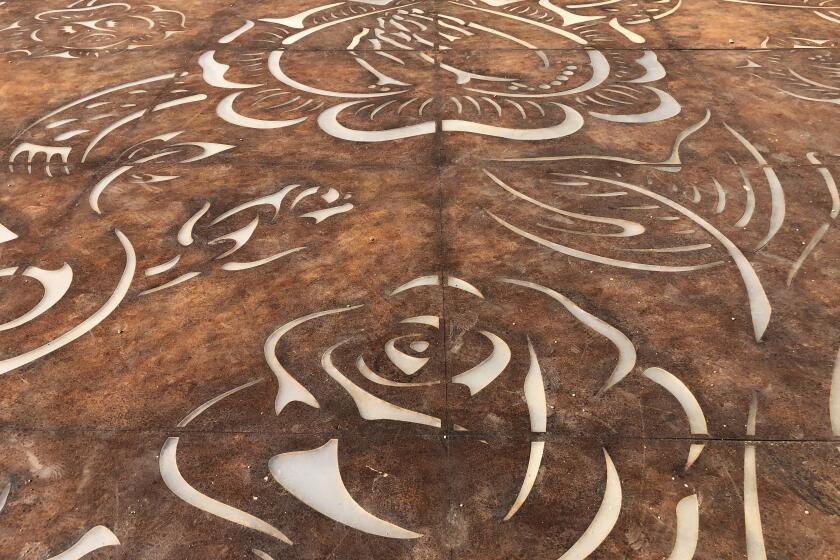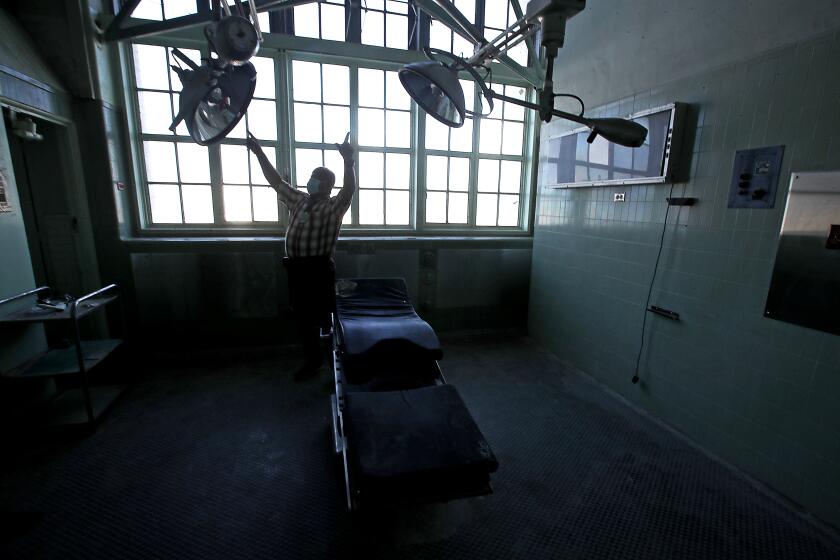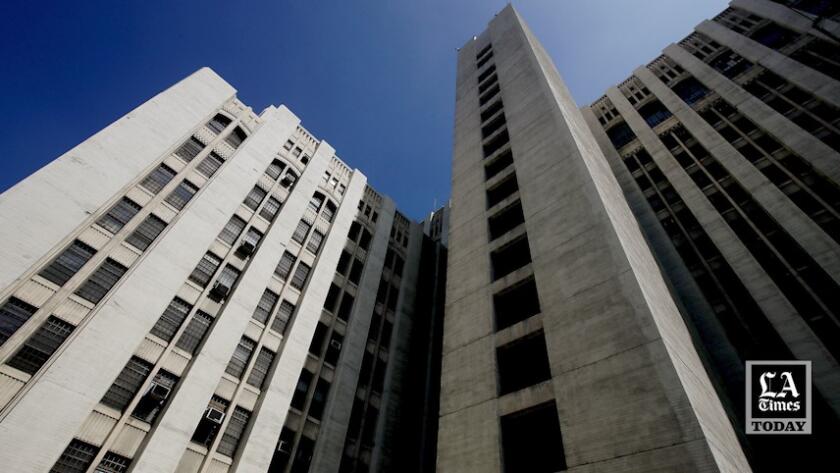A new General Hospital: Turning an iconic L.A. landmark into homeless housing
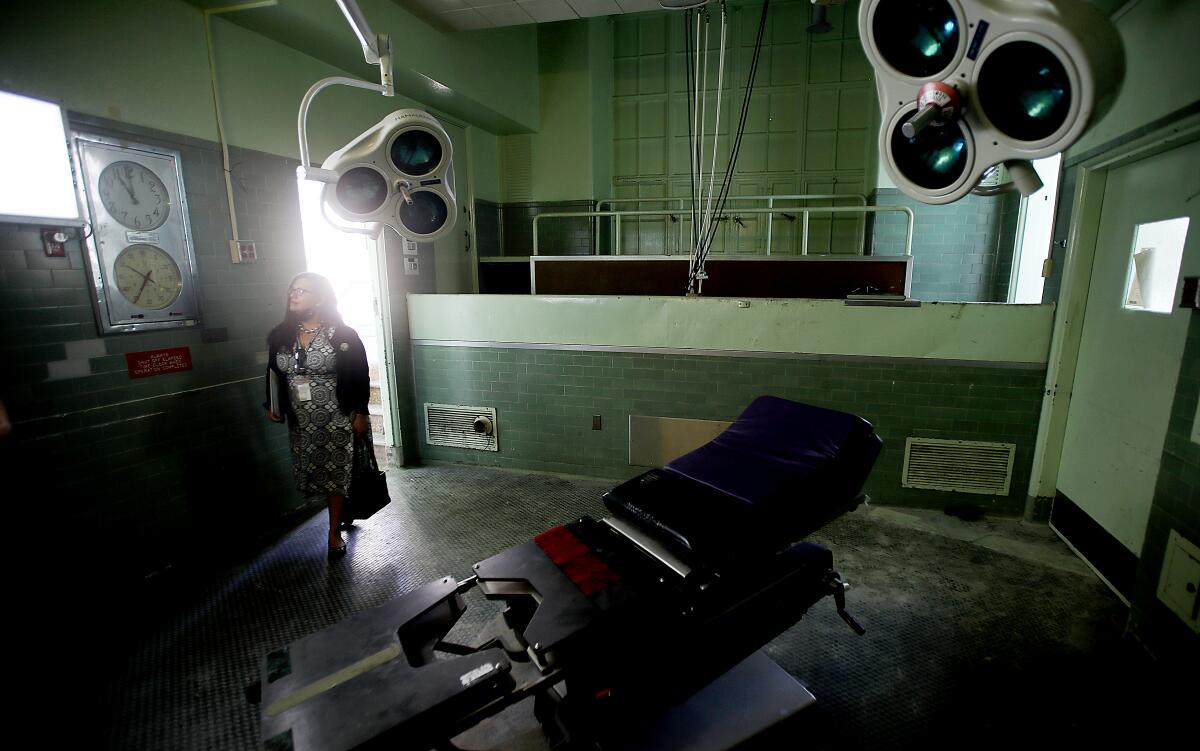
- Share via
The room is a marvel of architectural oddities. On one wall a cathedral-sized window frames the Eastside skyline. Facing it, several rows of wood-backed theater seats fan out, arching up at a dizzying angle to the ceiling three stories up.
The lone piece of furniture, a bedlike platform, stands on a pedestal in the center of the room.
Unchanged since the last patient left Los Angeles County General Hospital 14 years ago, the operating room encapsulates the rich opportunities and huge challenges for an institution that became too old and decrepit to go on as it was but is too much of a civic treasure to discard.
The hospital’s operating rooms — like so much of its 1.2 million square feet of wards, laboratories and double-wide corridors — are full of intriguing possibilities and head-scratching questions. What would an operating room be good for, after all, besides surgery?
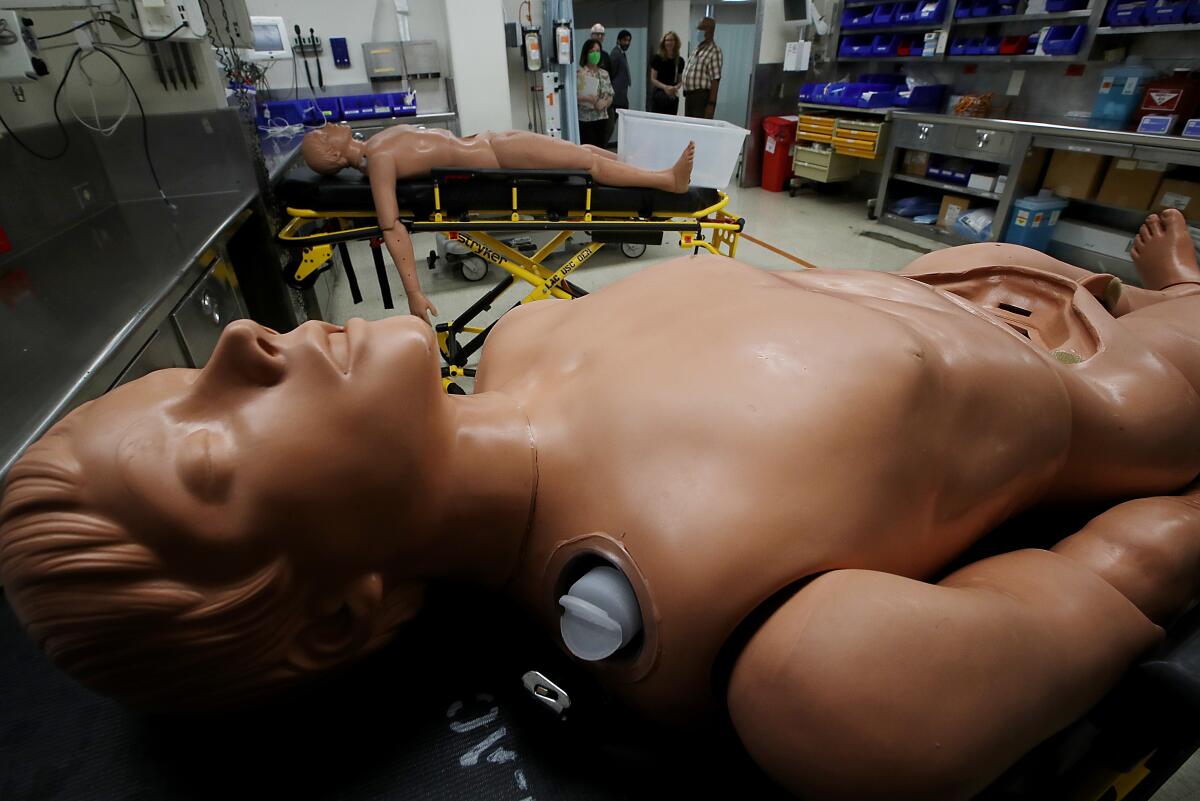
After years of stagnation and hand-wringing over what should become of the 100-year-old Art Deco monolith that towers over Boyle Heights, answers are beginning to take shape.
Los Angeles County, which owns the former hospital, has launched a multi-year program to reconfigure the H-shaped building into homeless and affordable housing. This will be the centerpiece of a “Healthy Village,” with as many as 1,400 units with beds for housing, and medical and mental health care. Spaces for social services, community activities, arts and retail will be spread over its spacious grounds.
Using state and local funds, the county has committed $250 million to take the first step, preparing the 19-story building for its remake. That alone will be a huge project: removing asbestos and other hazardous materials, upgrading electrical and water systems, installing air conditioning and fire sprinklers, restoring inoperative elevators and building seismic shear walls. The prep work is expected to start early next year and be finished by next summer.
And all that is to just get the building in shape as a blank slate for its reincarnation as hundreds of affordable apartments.
The county will also be seeking a developer early next year who has creative ideas — like what a three-story operating theater could become — to partner in the project, which is expected to require $1 billion or more in public and private financing.
It isn’t going to happen overnight. Through the end of this year, the county also will be consulting with community leaders to set broad goals for a development proposal that will encompass the hospital building and 12 acres of underutilized land to its west.
The final timeline is subject to negotiation with the developer. But construction would start in 2024 at the earliest, with completion in 2026.
On separate parcels on the northwest quadrant of the grounds, the county will continue developing the 8-acre Restorative Care Village, a complex of short-term and permanent housing for homeless patients with medical and mental health needs.
When all is done, the two “villages” will cover about 35 acres, stretching from Los Angeles County-USC Medical Center — General Hospital’s replacement — on the southeast to Mission Road on the west, with the reimagined hospital building towering over all, like a cathedral with two transepts.
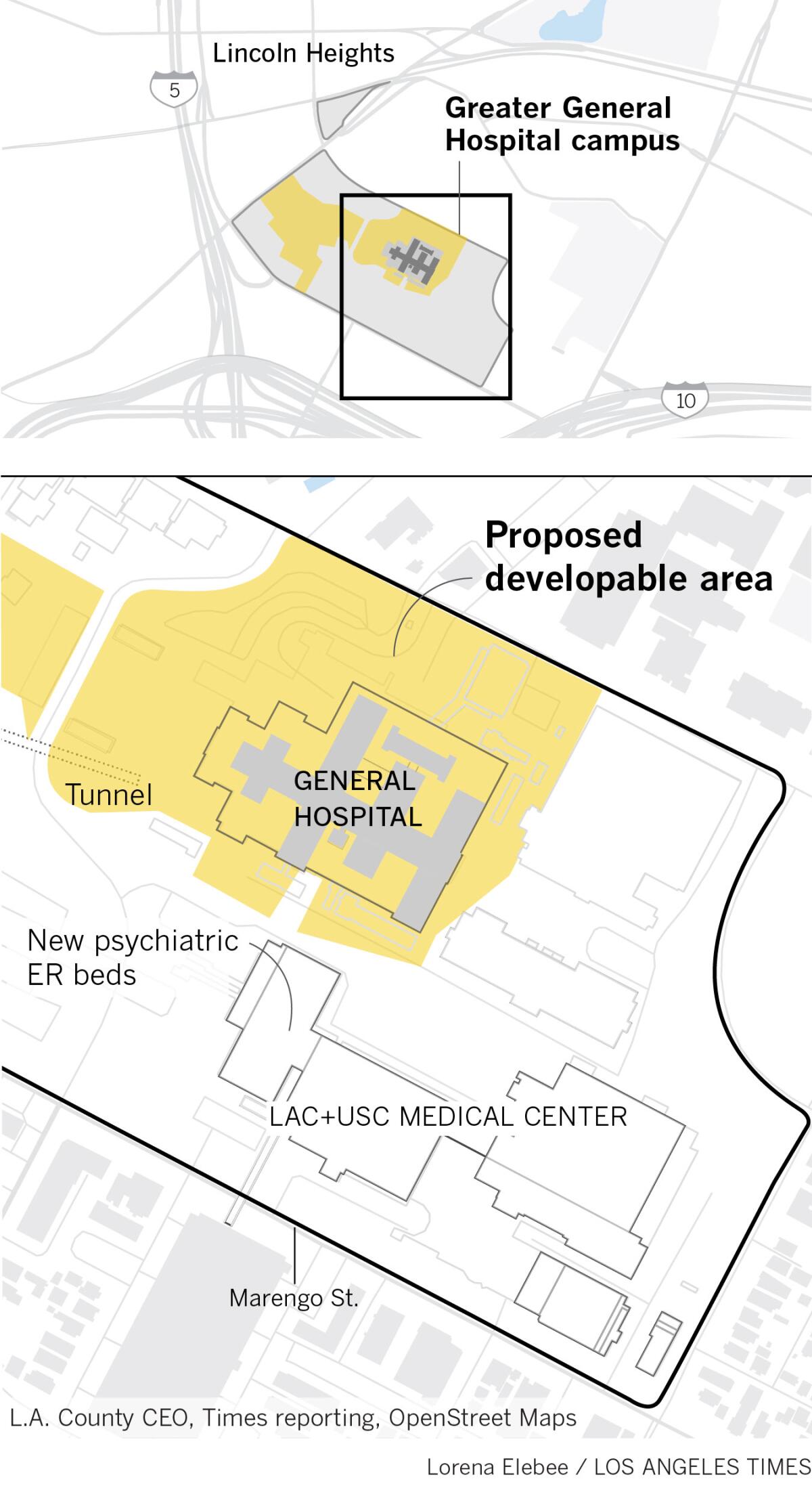
For more than a decade, the mothballed monument has been an object of curiosity and irritation for Eastside residents as they witnessed the spread of homeless camps around it and wondered why a resource of such great potential remained idle.
“There had been talks and studies about what it would take to rebuild the hospital, and it just wasn’t feasible,” said Frank Villalobos, founder of the prominent Eastside design firm Barrio Planners. “So, we’ve known for a while that something else had to be done.”
Architectural, cultural and environmental imperatives dictated against tearing the outmoded building down.
It represents one of the city’s best examples of Art Deco architecture on a monumental scale.
Its significance as the centerpiece of the county’s healthcare system is embodied in Salvatore Cartaino Scarpitta‘s concrete statues overlooking the entrance — the Angel of Mercy comforting an infirm couple flanked by Hippocrates, Louis Pasteur, Galen and other figures in medical history.
Inside the foyer, ceiling murals by artist Hugo Ballin depict Asclepius, the Greek god of medicine, and his sons in a “saint-like rendering” that, according to a review on the Los Angeles Conservancy’s website, suggests “an exalted place for the gods of medicine and their earthly instruments.”
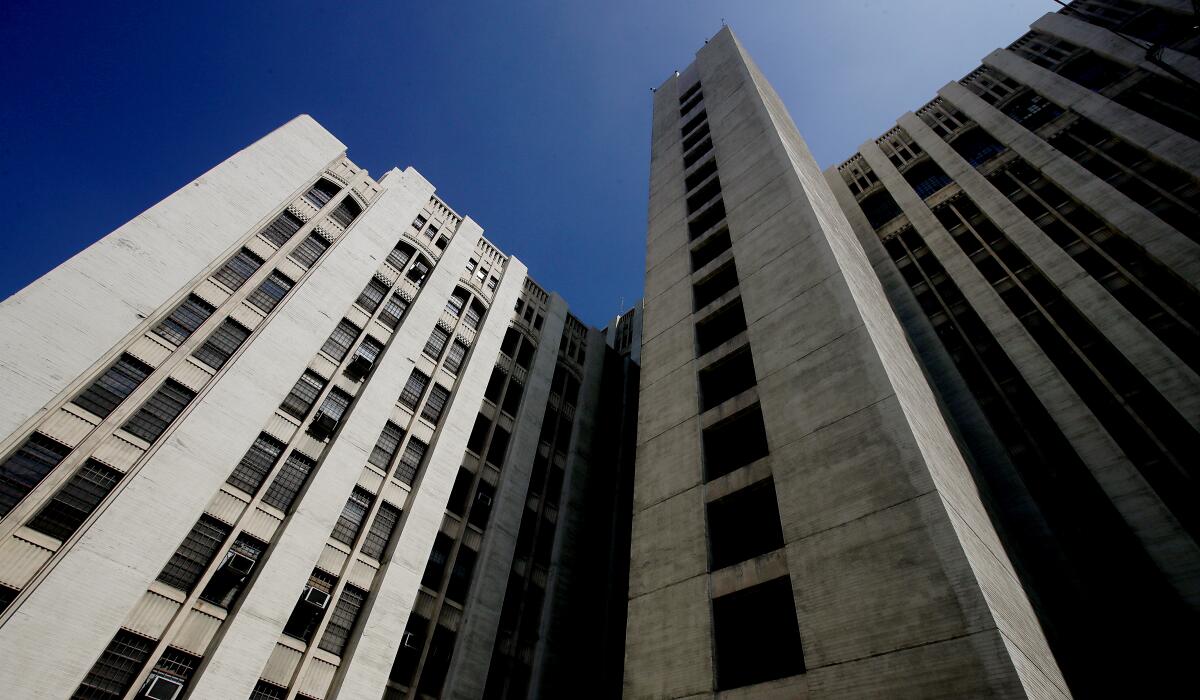
“Here you’ve got the biggest and best, a glorious building that has the possibility of connecting past, present and future,” said Michael Lehrer, former president of the American Institute of Architects Los Angeles. “I think it could be very powerful.”
Like City Hall and the Griffith Observatory, General Hospital is embedded in the identity of Los Angeles, standing broad-shouldered and tall in vistas from the 10 and 5 freeways or via a window seat on LAX’s flight path. It’s also a fixture in popular culture as the iconic hospital in the long-running TV soap opera of the same name.
More so than any other L.A. landmark, though, it was an intimate and generational presence in countless lives.
“When I’m driving back into the city from outside, I feel like I’m home when I see General Hospital,” said Monica Alcaraz, a Highland Park resident who, like her four siblings, was born in one of its labyrinthine corridors and lived its complicated history.
It’s where her mother was saved after having a heart attack in the mid-1990s.
Alcaraz gave birth to her own son in Women’s and Children’s Hospital, an adjacent building that was demolished last year. And there, in a much darker and more tragic chapter of the hospital’s history, her godmother was sterilized under California’s since-repealed eugenics law.
“She was always extra close to me,” Alcaraz, said. “I didn’t realize until much later that was because she had wanted more children and didn’t have the chance.”
Through its dominating presence on the Eastside and service to low-income residents there, the hospital holds an emotional bond to many who have since risen to prominence.
A reporter recalls his childhood in Boyle Heights, playing at County-USC and exploring its tunnels, nooks and stairwells.
Betty Avila, executive director of Boyle Heights’ Self Help Graphics & Art, went there when she broke her arm as a fourth-grader at Highland Park’s Buchanan Street Elementary School.
“I got my cast there and met all my appointments there,” Avila said. “The General Hospital has served as a place of physical healing.”
Funded by a 1923 bond issue, the city’s then-largest building was completed in 1932 and opened the next year with a lofty mission inscribed in stone at its entrance: “To provide care for the acutely ill and suffering to whom the doctors of the attending staff give their services without charge in order that no citizen of the county shall be deprived of health or life for the lack of such care and service.”
Over the years, General Hospital continued to succor the city’s indigent.
“One day, when I saw a homeless person who had been assaulted receiving the same respect and compassion as a CEO who had suffered a heart attack at Dodger Stadium — as they were lying on adjacent gurneys in our ER — I knew just how special a place General Hospital was and what a privilege it was to be a part of it,” Dr. Marc Eckstein wrote of his service there in a 2008 article for The Times on the hospital’s closure.
“Despite the crumbling physical plant, the lack of central air conditioning, the bloodstains on the gurneys and the graffiti on the bathroom walls, the care provided to our patients has rivaled or exceeded any private hospital in town,” he wrote.
But like its city, the hospital’s past is muddled.
Its predecessor, a nearby historic building currently occupied by the Los Angeles County coroner, was the birthplace of future Hollywood icon Marilyn Monroe while also the place where police, in the late 1920s, infamously committed the mother of a missing child for psychiatric evaluation when she — rightly — insisted that the boy they “recovered” was not hers.
In the 1970s, the building became the backdrop for protests by Chicano groups over the questionable sterilization of more than 200 mostly Latino and working-class women who came to Women’s and Children’s Hospital to deliver babies.
In 2018, the Board of Supervisors formally apologized for the sterilizations, which it said occurred between 1968 and 1974 “as a means of controlling the growth of ‘undesirable’ populations such as immigrants, people of color, poor people, unmarried mothers, people with disabilities, and the mentally ill.”
California established a restitution fund for survivors among the estimated 20,000 women sterilized under the state’s 1909 eugenics law, but the women sterilized at County-USC were not eligible because the hospital is locally funded. The state law was repealed in 1979.
Though the county did not have a program of forced sterilizations, the supervisors said it is questionable whether their consent was “truly informed” because of language and cultural barriers. Some did not understand until later that they had been sterilized.
“The women affected by this practice led the rest of their lives deprived of full reproductive freedom, an incalculable loss to themselves and their families,” Supervisor Sheila Kuehl said in taking the vote.
A monument commemorating their story was installed in August in a garden next to the hospital building.
Phung Huynh provides space to reflect on women’s bodily autonomy. Plus Dudamel’s new orchestra and the 6th Street Bridge in our weekly arts newsletter.
The building again became the backdrop of protests in 1989 when the organization Los Angeles ACT UP/LA conducted a week-long vigil there — complete with a soup kitchen — demanding a dedicated AIDS unit. After the protest later spilled into the Board of Supervisors’ meeting room, the county opened a 20-bed unit that year.
Even then the eventual demise of the county’s flagship hospital was foreseen.
As early as the 1960s, the facility was straining to keep pace with the demands of new medical technology. Lacking air conditioning and fire sprinklers, it was no longer compliant with tightening air quality and fire standards.
Twice, in 1963 and 1975, the county explored the possibility of replacing it but could not procure the funding.
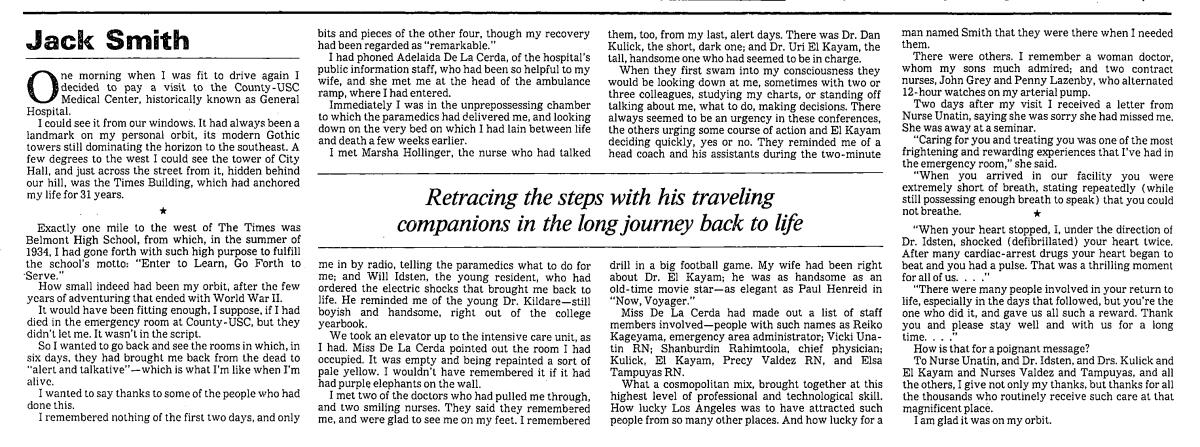
The supervisors voted in 1990 to begin construction of a replacement after the state agreed to pay 40% of the cost, proportionate to the percentage of the hospital’s patients covered by Medi-Cal. The plan left one more stain on the hospital’s standing with the surrounding community when hundreds of families were displaced to clear the way for the new facility known today as Los Angeles County-USC Medical Center.
On Jan. 17, 1994, the Northridge earthquake forced the permanent closure of a 166-bed psychiatric unit and led to new state seismic standards for hospitals that would require structural upgrades of the massive building.
With the new County-USC Medical Center finally completed, General Hospital closed on Nov. 7, 2008.
To a limited extent, it has remained a community asset with its Art Deco vestibule still open to the public. A wellness center occupies much of its vast first floor, and several research teams and training programs use space up to the fourth floor. But the remainder of its 19 floors have been abandoned and fallen into a state of dangling ceiling tiles, broken light bulbs, peeling paint, rusted piping and gathering dust.
Like the scent of decay, the question of what should be done with that space has hung in the air ever since.
Villalobos, the architect, said he first thought about converting at least a portion of the general hospital into housing when then-Supervisor Gloria Molina’s office released a report estimating that 19,000 Eastside residents had lost housing to freeway displacement.
His family was among them. In 1961, Villalobos, then an eighth-grader at St. Isabel School, and his family were evicted from their four-bedroom home near the intersection of South Fresno and Atlantic streets in Boyle Heights.
“It was a beautiful house in a beautiful community with a great view and next to a park,” said Villalobos, 76.
The home was bulldozed, and the property now sits under the Pomona Freeway, a tributary of the gigantic 27-lane East Los Angeles Interchange that carves up the Eastside. His school was demolished and rebuilt down the road.
In 1970, he and four friends created Barrio Planners, a nonprofit design firm that incorporates political activism and community involvement. The group innovated sound walls for Lincoln Heights’ Ramona Gardens project and aided in the expansion of the light-rail Gold Line through the Eastside.
The Board of Supervisors approved a motion to begin creating construction and financial plans for redeveloping the General Hospital building.
Shortly after the 1994 Northridge earthquake, Molina consulted with him on the hospital.
“If you really want to help the people evicted decades ago and those undergoing evictions today, then start with good construction and housing,” he recalled telling her.
For years nothing came of the talk, but a similar idea was germinating within the county health department.
“There were always conversations about that, but nothing that was viable,” said Mark Ghaly, then a deputy director in the department. “These ideas don’t percolate in weeks or months. It takes a while, for better or worse.”
In 2012, the county launched Housing for Health, a program that provides housing and services to medically vulnerable homeless people.
Ghaly, now secretary of the California Health and Human Services Agency, developed a blueprint for using General Hospital as housing surrounded by all the other health, mental health and addiction services that Housing for Health clients require.
“If you could transform that space into a place where vulnerable people could live and thrive, it does exactly what Housing for Health wanted to do, transform people’s lives,” he said.
Supervisor Hilda Solis, who succeeded Molina, embraced that concept in a 2018 motion that called for a feasibility study on converting the hospital to housing. Broadly defining community-oriented goals, she said the reborn building should complement the existing health services and focus on the most vulnerable population by providing recuperative care, housing, jobs and wraparound services.
The county hired AECOM, a national infrastructure analysis firm, to produce market studies and analyze the building’s structural integrity.
A critical part of feasibility was drawing support in a community that has been protective of its heritage.
Solis created an oversight group, the Health Innovation Community Partnership, which gathered leaders of nonprofits, businesses and resident associations from downtown to El Sereno to review the evolving plans.
More than 75 community engagement meetings, stakeholder interviews and pop-up events elicited neighborhood feedback. Community engagement volunteers spoke with more than a hundred members of the public at each event at locales such as the East Los Angeles Skills Center, City Terrace Park Community Center and Hollenbeck Middle School.
Among them was Villalobos, who has mounted opposition to plans he considered out of step with Boyle Heights, such as construction of a state prison in East Los Angeles and a proposal earlier this year to house up to 10,000 homeless people in the abandoned Sears Tower.
“Those types of projects have failed in Chicago and New York when you’re throwing masses of people on top of each other,” he said.
The much smaller but more targeted General Hospital approach is a winner, he contends.
“This is a fantastic vision,” he said.
- Share via
Watch L.A. Times Today at 7 p.m. on Spectrum News 1 on Channel 1 or live stream on the Spectrum News App. Palos Verdes Peninsula and Orange County viewers can watch on Cox Systems on channel 99.
Other participants brought their personal sensibilities of joy and heartache to the conversation.
Alcaraz, a former president of the Highland Park Neighborhood Council, sat in on dozens of the meetings and encouraged members of the unhoused community to voice their opinions. They asked for job and housing opportunities along with mental and physical health assistance.
A homeless advocate since 2013, she said her interest was piqued when discussions about the reuse of the hospital and nearby spaces included a Restorative Care Village.
“We received good turnout at the meetings from unhoused and lower-income families and individuals,” Alcaraz said. “They are part of this community, and it’s our ultimate goal to help them out of their situation.”
The plan to convert a portion of General Hospital into affordable housing seemed reasonable given the premium for such homes, Avila said.
Yet, the opportunity to rehabilitate the hospital’s image after the forced sterilizations was equally important for the artist.
“The trauma the Latino community faced entering these institutional places ranged from unwelcoming to dangerous,” she said. “I’m happy to be part of a healing space. Maybe we can get a supermarket in here.”
Avila, also a member of the steering committee, hopes that when plans are expanded, there will be a space for “art, culture and artistic programming,” she said.
“We have so much culture on the Eastside, and that should be incorporated in the new plans,” she said.
As the plan evolves, the partnership will consult on issues such as how the hospital’s unusual features — operating rooms, open bays and a library — could be adapted to community use and how wards will be reconfigured into housing. One key decision will be the size of the units. The feasibility study found a potential for 750 single units suitable for homeless people. The two- and three-bedroom family units favored by the community group would lower the total.
The county and community group will outline their goals in a request for proposals expected to be offered in January. Then the selected developer will negotiate with the county over the details. The final plan will depend on unknowns such as the availability of funding and the developer’s imagination.
“You imagine going down a really long hallway,” said Lehrer, the architect. “You might periodically blow out two or three rooms. All of a sudden the hallway is a collection of social spaces where you have light and views.”
By comparison, the West Campus, which will be a part of the development proposal, is a blank slate. Also up for grabs is 12 acres that includes bungalow offices, a windowless finance building, asphalt parking and a parking structure. Also to be determined is what to do with an architecturally significant aboveground tunnel linking the former hospital to a still-functioning pharmacy building. High priorities for community groups: more housing and public spaces for day care, cultural events, the arts and retail, especially a grocery store.
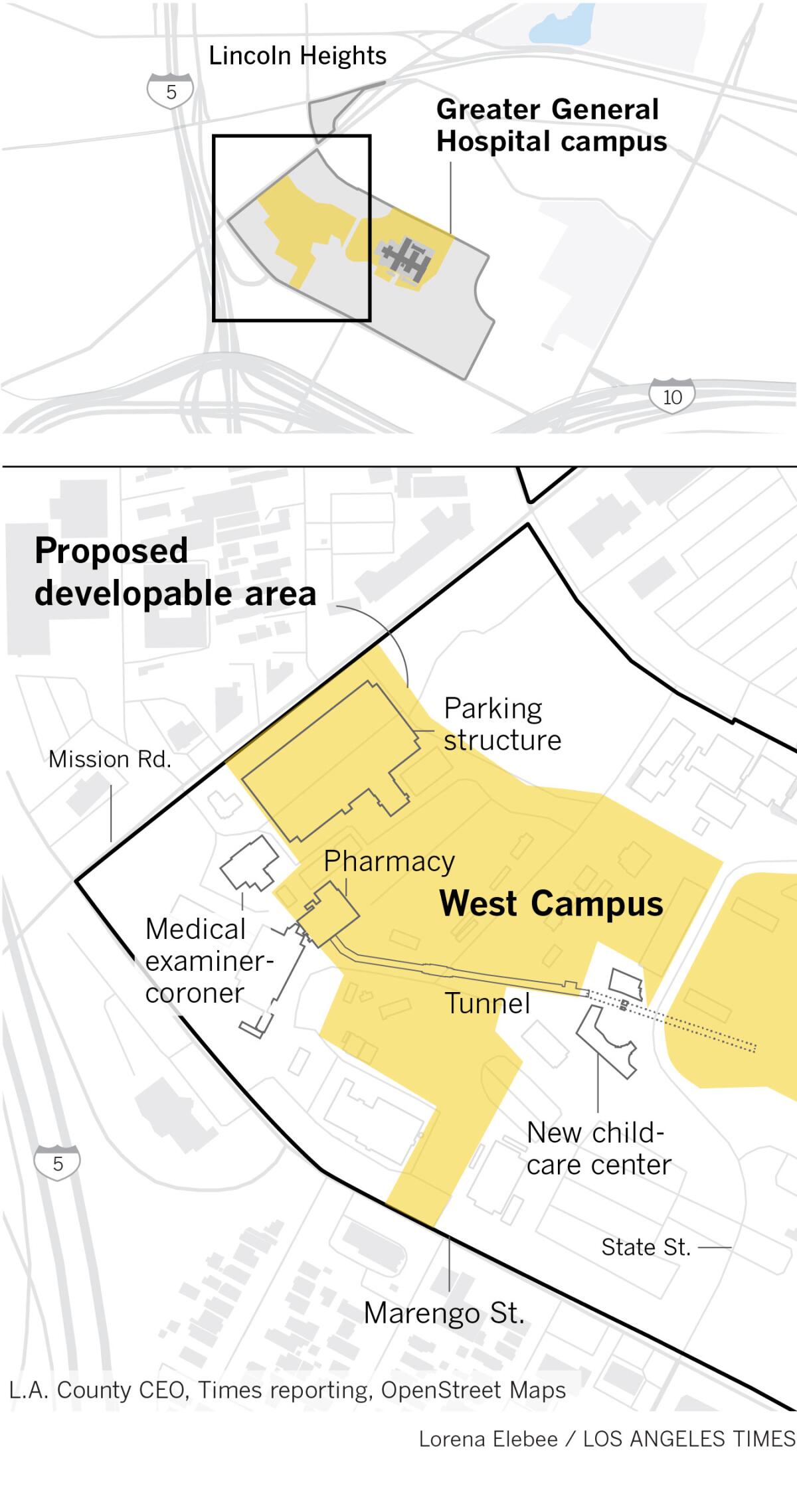
Ultimately, the decisions will rest between the county and the chosen developer, as long as they comport with Solis’ condition of relevance to community health.
Independently, the county will continue developing the Restorative Care Village, a multiphase project to fill some of the alarming gaps in short-term and permanent housing and treatment for medical and mental health patients.
The project had its Phase 1 grand opening July 6, in which a four-story, 96-bed recuperative care center was opened. Homeless patients leaving County-USC Medical Center can stay there for up to a few months while completing their recovery.
Sixty-four beds of residential mental health care were also completed, providing an alternative to general shelter for patients leaving a psychiatric ER.
The site of the former Women’s and Children’s Hospital, now an empty lot, is slated for an additional 64 beds of mental health care, a job development center and possibly additional medical recovery and mental health urgent care.
Last month, the supervisors entered an exclusive negotiating agreement with Century Housing to build 300 units of homeless and affordable housing on a former laboratory site at the northwest corner of the village.
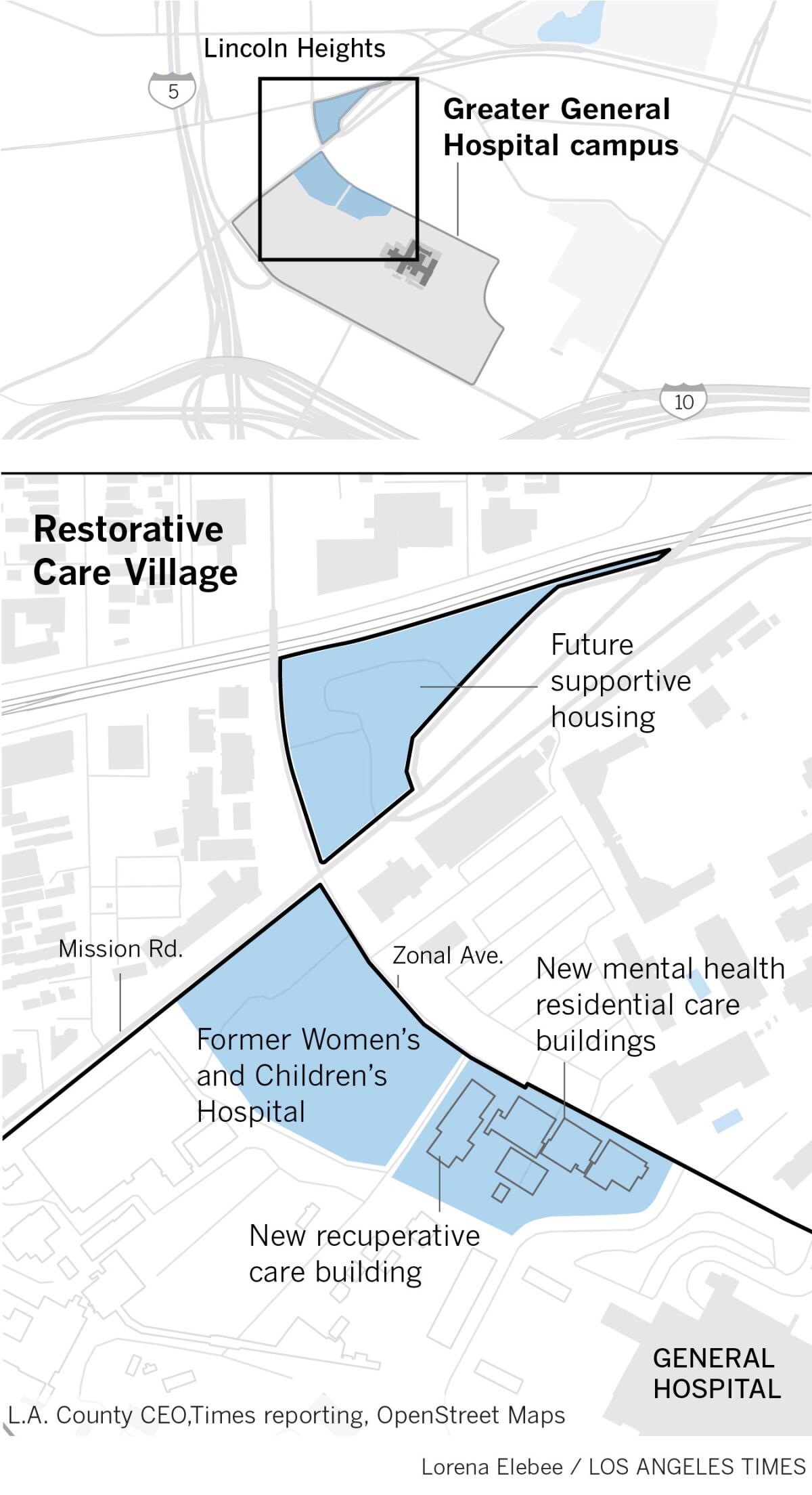
The all-encompassing ambition of the hospital project, the Restorative Care Village and the West Campus has caught the attention of film mogul Jeffrey Katzenberg, who has been working behind the scenes on the homeless issues and is lobbying state officials for funding of the health and mental health facilities.
Katzenberg sees the project as a national model for integration of healthcare, housing and workplace development.
“What’s so great about this facility is that it’s an opportunity to integrate all this into a single location where you can really move people, hopefully, from the street through their health issues into housing,” Katzenberg said.
“That’s got the scale that allows this to occur.”
More to Read
Sign up for Essential California
The most important California stories and recommendations in your inbox every morning.
You may occasionally receive promotional content from the Los Angeles Times.
